
Standard
Source: www.fci.be
FCI Standard N° 156 / 2011.01.19.
Collie
color chart
(by the book of Dr. Sharon Vanderlip (USA), referenced at Wisewyn Kennel
(P), .pdf, 237 KB)
(Proportional representation: Andrea Leidl)
The
Collie Standard
(by Mia Ejerstad, Handler,
Groomer, Breeder (Steadwyn Kennel), book 2010, 185 pages)

Collie
standard illustrations
(by Helen Catherine Cramer, Myoene Kennel, AUS)
History
of the collie
(by Chekia Kennel, USA)
Breeding
for a future
(by Angela Harvey, Wicani Kennel, UK)
___________________________________________________________________
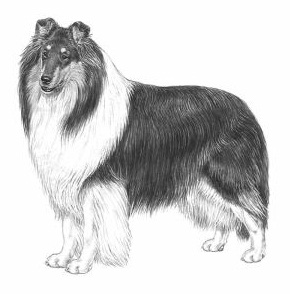
©M.
Davidson, illustr. NKU Picture Library
This
illustration does not necessarily show the ideal example of the breed.
ORIGIN: Great Britain.
DATE OF PUBLICATION OF THE OFFICIAL VALID STANDARD: 13.10.2010.
UTILIZATION: Sheepdog.
FCI-CLASSIFICATION:
-
Group 1 Sheepdogs and Cattle Dogs (except Swiss Cattle Dogs).
-
Section 1 Sheepdogs.
-
Without working trial.
BRIEF HISTORICAL SUMMARY: The rough and the smooth Collie is the same with the exception of coat length. The breed is thought to have evolved from dogs brought originally to Scotland by the Romans which then mated with native types. Purists may point to subtle differences which have appeared as individual breeders selected stock for future breeding, but the fact remains that the two breeds derived very recently from the same stock and, in truth, share lines which can be found in common to this day. The Rough Collie is the somewhat refined version of the original working collie of the Scottish shepherd, from which it has been selected over at least a hundred years. Many of the dogs can still perform satisfactorily at work, offered the chance. The basic message is that for all his beauty, the Collie is a worker.
The below illustrations and small font explanations are NOTpart of the original standard but I hope they help your understanding.
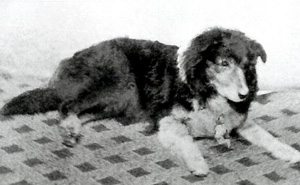
Old
Cockie, the dog considered ancestor of all collies (source: Checkia
Collies (USA))
GENERAL APPEARANCE: Appears as a dog of great beauty, standing with impassive dignity, with no part out of proportion to whole. Physical structure on lines of strength and activity, free from cloddiness and with no trace of coarseness. Expression most important. In considering relative values it is obtained by perfect balance and combination of skull and foreface, size, shape, colour and placement of eyes, correct position and carriage of ears.
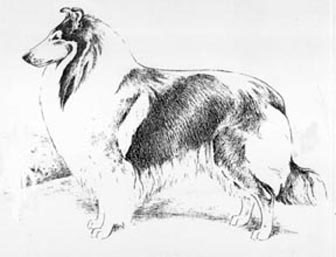
Collie ideal
male standard picture (source: Helen
Catherine Cramer (AUS) illustration page)
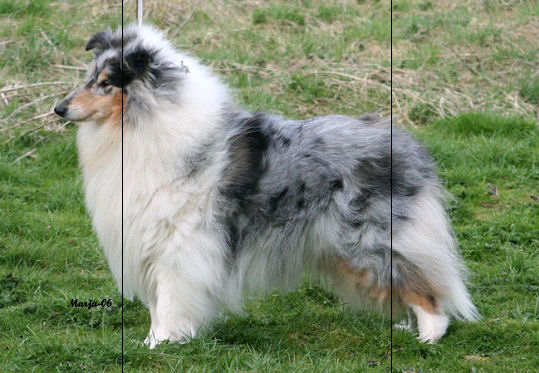
Draw an imaginary line from the ear set to the ground, if the angulation
is correct the line should touch the ground IN FRONT of the front feet.
Now draw an imaginary line from tail set to ground, remember the key
here is the TAIL SET and not the backside. The dogs hock should stand
behind the point that the line touches the floor (picture: CH Wicani
Darling, source: Angela
Harvey, Wicani Kennel (UK))
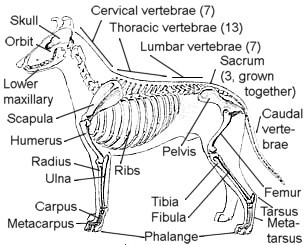
Collie skeleton (picture source: Helen
Catherine Cramer (AUS) anatomy page, names of bones: Andrea Leidl)
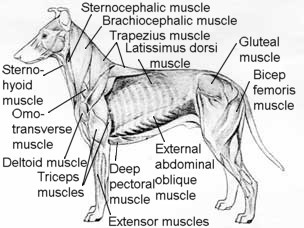
Collie muscles (picture source: Helen
Catherine Cramer (AUS) anatomy page) names of muscles: Andrea Leidl)
BEHAVIOUR AND TEMPERAMENT: Friendly disposition with no trace of nervousness or aggressiveness. A great companion dog, friendly, happy and active, good with children and other dogs.
HEAD: Head properties of great importance must be considered in proportion to size of dog. Viewed from front or side, head resembles a well-blunted clean wedge, being smooth in outline. Sides taper gradually and smoothly from ears to end of black nose. Viewed in profile, top of skull and top of muzzle lie in two parallel straight lines of equal length divided by the stop. A mid-point between inside corner of eyes (which is centre of a correctly placed stop) is centre of balance in length of head. Depth of skull from brow to underpart of jaw never excessive (deep through).

Correct
head (source: Helen
Catherine Cramer (AUS) illustration page, illustration by Lorraine
B. Still, USA)
CRANIAL
REGION:
Skull: Flat.
Stop: Slight, but perceptible.
FACIAL
REGION:
Nose: Always black.
Muzzle: End of smooth, well rounded muzzle blunt, never square. Not
pinched.
Jaws / Teeth: Jaws strong, under-jaw clean cut. Teeth of good size.
A perfect, regular and complete scissor bite, i.e. upper teeth closely
overlapping lower teeth and set square to the jaws.
 .
. .
. .
.
Collie
dentition (source: VideoJug
Collie Teeth Pages, numbering and colour coding: Andrea Leidl)
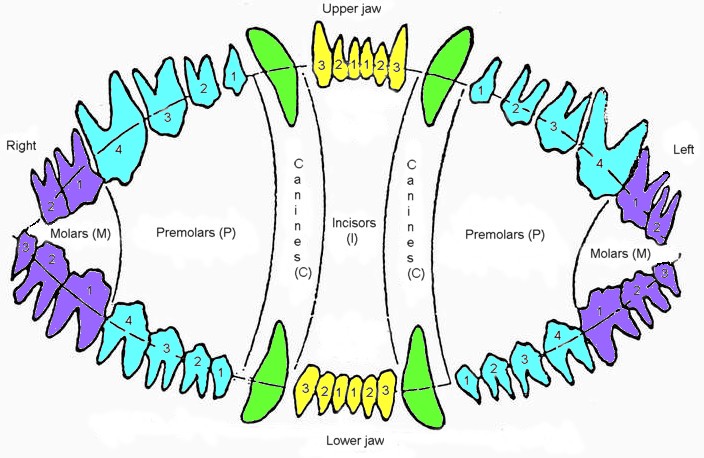 .
.
Dog dentition
scheme (permanent teeth at an adult dog, total 42 teeth (upper: 20,
lower: 22)) (colour coding: Andrea Leidl)
|
Side |
Left
|
Right
|
||||||
|
Description |
Molar
|
Premolar
|
Canine
|
Incisor
|
Incisor
|
Canine
|
Premolar
|
Molar
|
|
Latin Name |
Dentis Molaris |
Dentis
Praemolaris
|
Dentis
Caninus |
Dentis
Incisivus |
Dentis
Incisivus |
Dentis
Caninus |
Dentis
Praemolaris |
Dentis |
|
Abbreviation |
M
|
P
|
C
|
I
|
I
|
C
|
P
|
M
|
|
Upper |
2
|
4
|
1
|
3
|
3
|
1
|
4
|
2
|
|
Lower |
3
|
4
|
1
|
3
|
3
|
1
|
4
|
3
|
Dog
dentition scheme (permanent teeth at an adult dog) (colour coding: Andrea
Leidl)
 .
.
Correct scissor bite: inner surface of the upper incisors covers in
one third the outer surface of the lower incisors
(picture source: Helen
Catherine Cramer (AUS) anatomy page)
Most common bite faults:
 .
. .
.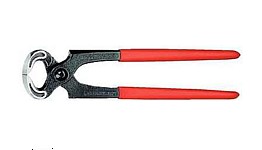
Even bite
(pincers bite) (incorrect): with a slight overdevelopment of the lower
jaw, the upper and lower incisors meet on atop (wears down quickly)
(1st picture source: Helen
Catherine Cramer (AUS) anatomy page, 2nd picture source: Csaba Pettkó,
Leitfader für Zuchtrichter VDH)
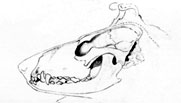 .
. .
.
Undershot
bite (pike bite) (incorrect): lower incisors are in front of the upper
incisors. Upper jaw is shorter, lower jaw is of correct size.
(1st picture source: Helen
Catherine Cramer (AUS) anatomy page, 2nd picture source: Csaba Pettkó,
Leitfader für Zuchtrichter VDH)
 .
. .
.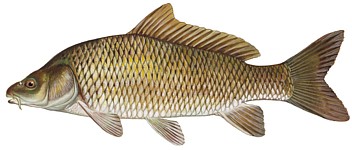
Overshot
bite (carp bite) (incorrect): upper incisors are at greater distance
in front of the lower incisors.
(1st picture source: Helen
Catherine Cramer (AUS) anatomy page, 2nd picture source: Csaba Pettkó,
Leitfader für Zuchtrichter VDH)
Cheeks:
Cheekbones not prominent.
Eyes: Very important feature giving sweet expression. Medium size (never
very small) set somewhat obliquely, of almond-shape and dark brown colour,
except in the case of blue merles when eyes are frequently (one or both,
or part of one or both) blue or blue-flecked. Expression full of intelligence,
with quick, alert look when listening.
Ears: Small, not too close together on top of skull, nor too far apart.
In repose carried thrown back, but on alert brought forward and carried
semi-erect, that is, with approximately two-thirds of ear standing erect,
top third tipping forward naturally, below horizontal.
NECK: Muscular, powerful, of fair length, well arched.
BODY:
Slightly long compared with height.
Back: Firm.
Loin: Slight rise.
Chest: Deep; fairly broad behind shoulders; ribs well sprung.
TAIL: Long with bone reaching at least to hock joint. Carried low when quiet but with slight upward swirl at tip. May be carried gaily when excited, but never over back.

Correct
tail (source: Helen
Catherine Cramer (AUS) anatomy page)
LIMBS
FOREQUARTERS:
Shoulder: Sloping and well angulated.
Elbow: Neither turned in nor out.
Forearm: Forelegs straight and muscular, with moderate amount of round
bone.
Forefeet: Oval; soles well padded. Toes arched and close together.
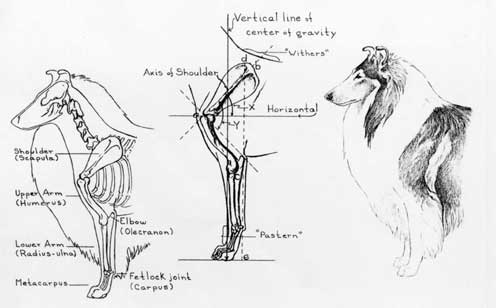
Forequarters
(source: Helen
Catherine Cramer (AUS) anatomy page)
 .
.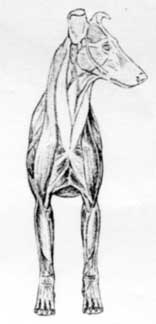 .
.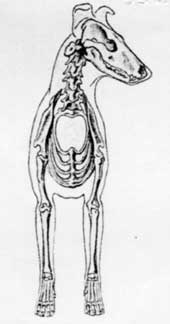
Correct
front, muscles and skeleton (source: Helen
Catherine Cramer (AUS) anatomy page)
HINDQUARTERS:
Thigh: Muscular.
Stifle (Knee): Well bent.
Lower thigh: Clean and sinewy.
Hock joint: well let down and powerful.
Hind feet: Oval; soles well padded. Toes arched and close together.
Slightly less arched than forefeet.
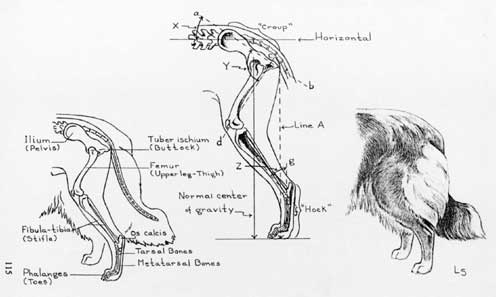
Hindquarters
(source: Helen
Catherine Cramer (AUS) anatomy page)
 .
. .
.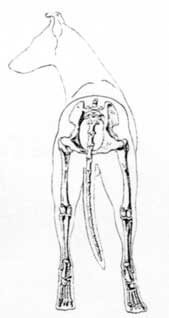
Correct
hindquarters, muscles and skeleton (source: Helen
Catherine Cramer (AUS) anatomy page)
GAIT / MOVEMENT: Distinctly characteristic in this breed. A sound dog is never out at the elbow, yet moves with front feet comparatively close together. Plaiting, crossing or rolling is highly undesirable. Hind legs from hock joint to ground when viewed from rear to be parallel but not too close; when viewed from side, action is smooth. Hind legs powerful with plenty of drive. A reasonably long stride is desirable and should be light and appear effortless. Absolute soundness essential.
COAT:
Hair: Fits outline of body, very dense. Outer coat straight and harsh
to touch, undercoat soft, furry and very close almost hiding the skin;
mane and frill very abundant, mask and face smooth, ears smooth at tips,
but carrying more hair towards base, front legs well feathered, hind
legs above hocks profusely feathered, but smooth below hock joint. Hair
on tail very profuse.
Colour: Sable, Sable and white, Tricolour and Blue Merle.
Sable: any shade of light gold to rich mahogany or shaded sable. Light straw or cream coloured highly undesirable.

Millie's
grandfather HCH Rineweld
Kid Don't Give Up "Rygelth"
Tricolour: predominantly black with rich tan markings about legs and
head. A rusty tinge in top coat highly undesirable.

Millie's
sire HJCH, HCH, ROCH, Junior BOG, Club Star Stud Dog Rineweld
Time of Black Knight "Kyuss"
Blue
Merle: predominantly clear, silvery blue, splashed and marbled with
black. Rich tan markings preferred, but absence should not be penalised.
Large black markings, slate colour, or rusty tinge either of top or
undercoat are highly undesirable.

Millie's
great-grandmother WJCH 2001, WCH 2003, ICH, HCH,
Club Winner, BIS Rineweld
Awantgarde at Shewenna "Shanza"
All should carry typical white Collie markings to a greater or lesser degree. Following markings are favourable - white collar, full or part, white shirt, legs and feet, white tail tip. A blaze may be carried on muzzle or skull, or both.
SIZE:
Height at the withers:
-
Males: 56 - 61 cms.
-
Females 51 - 56 cms.
FAULTS: Any departure from the foregoing points should be considered a fault and the seriousness with which the fault should be regarded should be in exact proportion to its degree and its effect upon the health and welfare of the dog and on its ability to perform its traditional work.
-
Aggressive or overly shy.
-
Any dog clearly showing physical or behavioural abnormalities shall be disqualified.
N.B.: Male animals should have two apparently normal testicles fully descended into the scrotum.
© www.millie.hu












